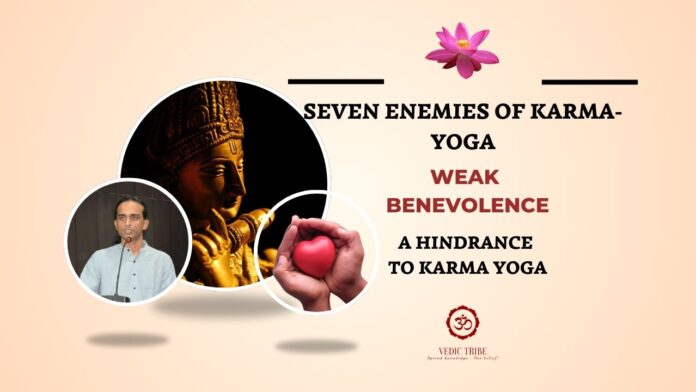Weak Benevolence: A Hindrance to Karma Yoga
In the previous article, we discussed “jelousy” as an enemy of Karma-Yogi and in this article we will discuss another enemy – “weak benovelence”.
Benevolence, the desire to help others, is a noble quality. However, unchecked benevolence can be perceived as weakness, leading to exploitation.
Unlike individuals driven by personal gain or material rewards, a Karma Yogi performs their duties selflessly, viewing them as a means of service to a larger purpose.
At the core of Karma Yoga lies the principle of selfless action. A Karma Yogi performs their duties without attachment to the results. Their primary motivation is not personal gain but a desire to contribute to the well-being of others and the world around them.
Consequently, Karma Yogis face a heightened risk of exploitation.
The Problem of Unchecked Benevolence:
Perception of Weakness: When an individual consistently prioritizes the needs of others above their own, they may be seen as weak and easily manipulated.
Exploitation: Others may take advantage of their generosity, demanding favors or resources without reciprocation.
Self-Neglect: Excessive selflessness can lead to neglect of one’s own needs, both physical and emotional.
The Influence of Asceticism:
In some Indian cultures, particularly those influenced by Buddhism and Jainism, there is a strong emphasis on renunciation and self-denial.
These philosophies give good ideas about suffering. They also emphasize the importance of detachment. But, too much focus on asceticism can be harmful. It can cause people to ignore taking care of themselves. It can also weaken their strength, determination, and enthusiasm.
Overcoming Weak Benevolence:
Understanding the paradox: The paradox of benevolence, when rendered weak, reveals a fundamental tension within the human spirit: the impulse toward selfless giving versus the imperative of self-preservation. This weakness arises from an imbalance, a dominance of the sattvic guna, which, while fostering compassion, neglects the necessary rajasic vigor required for its sustainable expression.
A synthesis: True benevolence, therefore, is not a unilateral act of surrender, but a dialectical synthesis. It demands the cultivation of rajasic fortitude, a tempered assertiveness that safeguards the self, thereby enabling the enduring practice of sattvic virtues. In this integration, benevolence transcends its fragile form, becoming a potent force for good, anchored in the wisdom of balanced existence.
Finding the Balance: Sattvic and Rajasic Qualities
The key lies in finding a balance between benevolence (sattvic guna) and self-preservation (rajasic guna).
Gold plus copper: Pure gold is very soft and malleable. While beautiful, it’s not practical for many uses, like jewelry or tools, because it bends and scratches easily. Adding a small amount of copper to gold creates an alloy that is much stronger and more durable. This alloy retains the beauty of gold but becomes usable for various purposes.
Sattva plus Rajas: A life lived solely in sattva might be peaceful but lack the drive and energy needed to achieve goals, overcome challenges, or contribute to the world. Rajasic qualities provide the necessary impetus for action, progress, and achievement. Therefore, a balanced mixture is essential for Karma Yogi.
To do:
Identify Your Limits: Clearly understand what you are willing and able to give, in terms of time, energy, resources, and emotional investment.
Establish Non-Negotiables: Determine what actions or behaviors you will not tolerate, even in the name of compassion.
Communicate Boundaries: Learn to assert your boundaries respectfully but firmly. Practice saying “no” without feeling guilty.
Self-Awareness: Recognize your own needs and boundaries.
Assertiveness: Learn to express your needs and boundaries assertively and respectfully.
Self-Preservation: Prioritize your own well-being while still being compassionate towards others.
Discernment: Learn to distinguish between genuine need and undue demands.
By cultivating a balance between benevolence and self-preservation, we can avoid exploitation while still living a life of service and compassion. This is crucial for those practicing karma yoga, as it allows them to maintain their inner peace and continue their spiritual journey without being unduly burdened.
In the next article, we will discuss the sixth enemy “Compensation effect”.
Madhwesh K
Vedic Tribe

